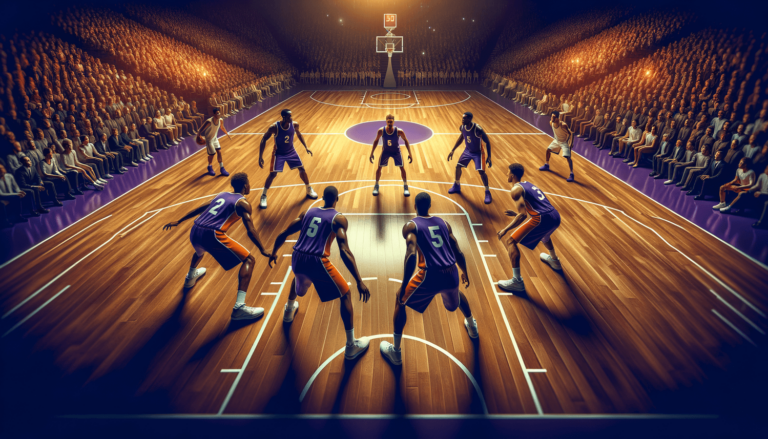
Welcome to the ultimate guide on mastering the enigmatic 1-2-2 zone defense in basketball! If you’ve always been curious about this impressive defensive strategy, you’ve come to the right place. In this blog post, we’ll dive into the intricacies of this unconventional defensive format, shedding light on how it works, when to use it, and why it can be such a game-changer. So, buckle up, basketball fans, because we’re about to embark on an exciting journey exploring one of the sport’s lesser-known yet highly effective strategies!
What’s a 1-2-2 Zone Defense in Basketball?
A 1-2-2 zone defense is a basketball strategy where players are positioned in a 1-2-2 formation and are responsible for guarding specific areas of the court, rather than individual opponents. This defense features one player at the point, two players on the wings, and two players down low. Its primary goal is to disrupt offensive plays, force turnovers, and limit inside scoring opportunities while encouraging more challenging perimeter shots.
Breaking Down the 1-2-2 Zone Defense
The 1-2-2 zone defense is a highly adaptable and versatile strategy that can be tailored to counter various offensive threats effectively. In this section, we’ll dissect the primary roles and responsibilities of each player within the 1-2-2 formation, helping you better understand how they collaborate to stifle the opposition.
The Point Guard’s Role (1)
The point guard (PG), often tagged as the “floor general,” takes the critical position at the top of the 1-2-2 zone, functioning as the first line of defense. Their role involves applying defensive pressure to the ball-handler and guiding them towards the wing players. This, in turn, creates trapping opportunities or forces the offense to make uncomfortable passes, increasing the chances of a turnover. Additionally, the point guard communicates with teammates, directing defensive adjustments and calling out motions to be aware of.
The Wings’ Role (2)
Next up, we have the two wing players, commonly the shooting guards (SG) or small forwards (SF). They’re positioned on each side of the court, between the three-point line and the free-throw line extended. The wing players play crucial roles in the 1-2-2 zone, as they trap ball-handlers with the point guard, close out on nearby shooters, and deny passing lanes to disrupt the flow of the offense. Quickness, anticipation, and agility are critical attributes for these players, as they’re required to make fast decisions and strong defensive rotations.
The Post Players’ Role (2)
At the base of the 1-2-2 zone, you’ll find the power forward (PF) and center (C) players who are tasked with clogging the key and contesting shots around the basket. Their primary duties include shot blocking, defensive rebounding, and providing help-side defense when ball-handlers penetrate the zone. Additionally, these post players must also effectively communicate defensive adjustments with their teammates to maintain the zone’s integrity.
Key Strategies for Employing a 1-2-2 Zone Defense
Now that we have a solid understanding of player responsibilities within the 1-2-2 zone, let’s delve into key strategies that can help maximize the effectiveness of this defense. By leveraging these practical tips, your team will be well-equipped to disrupt any opponent’s offensive flow.
1. Effective Trapping and Ball Pressure
One of the primary strengths of the 1-2-2 zone is its ability to generate trapping opportunities, particularly on the wings. When the ball-handler is guided toward the sideline by the point guard, the wing player should move in and pressure the ball-handler, resulting in a trap. Timely traps and relentless ball pressure are essential ingredients for a successful 1-2-2 zone defense, as they increase the likelihood of steals and forced errors.
2. Active Hands and Denying Passing Lanes
In a 1-2-2 zone, communication and coordination are crucial for denying passing lanes effectively. Wing players must work cohesively with both the point guard and post players to intercept and deflect passes. Emphasis should be placed on maintaining active hands, adjusting constantly to ball movement, and positioning to minimize easy passes between opponents. Denying these lanes severely limits an opposing team’s scoring options and frequently forces them into low-percentage shots.
3. Rapid and Accurate Rotations
Player rotations in a 1-2-2 zone must be fast and accurate to counteract an opponent’s off-the-ball movement and quick passing. All five players should be continually adjusting their positions to maintain the zone’s integrity and exploit offensive weaknesses. This requires an intense focus and an unrelenting commitment to maintaining defensive discipline both on and off the ball.
4. Effective Rebounding and Boxing Out
Rebounding is a critical component of any successful defense, and the 1-2-2 zone is no exception. One potential drawback of zone defenses is that they can be vulnerable to offensive rebounds. This makes it crucial for post players and wings to box out opponents and secure defensive boards. The wings should crash the boards, while the post players maintain primary responsibility for cleaning up the glass. Dominating the rebound battle can effectively negate any advantages obtained by the offense and fuel your team’s transition attack.
Embracing the Flexibility of the 1-2-2 Zone Defense
As we’ve mentioned earlier, the 1-2-2 zone defense is an adaptable and versatile strategy that can be modified to address specific threats or capitalize on your team’s strengths. Let’s take a look at some of the ways you can tweak the 1-2-2 zone to optimize its effectiveness on the basketball court.
1. Half-Court Press: 1-2-2 Zone Trap
By extending the 1-2-2 zone into a half-court press or full-court press, you can apply even more pressure on the opposing team, forcing them to make rushed decisions and commit costly mistakes. This strategy is particularly useful when you’re looking to increase the tempo of the game or if you possess a roster full of quick, athletic defenders capable of tormenting ball-handlers the moment they cross half-court.
2. Matchup Zone Principles
Integrating matchup zone principles into your 1-2-2 zone defense can significantly enhance its effectiveness. A matchup zone essentially marries the concepts of zone and man-to-man defense, with players responsible for guarding specific zones, but also accountable for picking up offensive players who enter their area. This hybrid approach can make it difficult for opposing teams to identify and exploit gaps in the defense, forcing them to rely on inefficient isolation plays or contested shots.
3. Sliding into a 2-1-2 Zone
Another tactical variation to consider is transitioning from a 1-2-2 zone to a 2-1-2 zone during the course of a game. By adjusting your team’s defensive alignments, you can force the opposition to adjust their offensive sets constantly, leaving them guessing as to which zone they’ll confront on the next possession. The element of surprise can become a powerful ally, disrupting even the most potent offenses in basketball.
Countering the 1-2-2 Zone Defense: An Offensive Perspective
To truly understand and appreciate the nuances of the 1-2-2 zone defense, it’s essential to analyze it from an offensive standpoint. By dissecting the most effective ways to exploit this defensive set-up, you’ll deepen your understanding of its strengths and weaknesses, making you a more knowledgeable and well-rounded basketball strategist.
1. Ball Movement and Player Movement
When facing a 1-2-2 zone, it’s crucial for an offense to maintain constant ball movement and player movement to stretch the defense, exploit gaps, and create open shots. By swinging the ball around the perimeter, making quick passes, and utilizing skip passes, the offense can force the defense to rotate, increasing the chances of finding an open teammate for an uncontested shot.
2. Exploiting the High Post and Short Corner
The 1-2-2 zone can be vulnerable in two areas, specifically the high post (the area around the free-throw line) and the short corner (the space between the baseline and the low block). By attacking these gaps, the offense can collapse the defense and create high-percentage scoring opportunities. Effective deployment of a versatile big man or a crafty wing player in these areas can pay dividends by drawing defenders out of position, opening up scoring lanes, and triggering defensive breakdowns.
3. Attacking from the Weak Side
Zone defenses often expose weaknesses on their weak side, and the 1-2-2 is no exception. By using creative off-the-ball cuts, cross-court passes, and diagonal drives, offensive players can exploit these openings to generate uncontested shots and scoring opportunities. A well-timed lob pass or a quick skip pass can often catch defenders out of position, leading to high-percentage shots close to the basket or wide-open three-point attempts.
Conclusion: Mastering the 1-2-2 Zone Defense in Basketball
By now, you should have a comprehensive understanding of the 1-2-2 zone defense in basketball, along with the key strategies that can optimize its effectiveness on the court. As a flexible and versatile option, the 1-2-2 zone can be tailored to your team’s strengths and your opponents’ weaknesses, making it a potent weapon in your defensive arsenal. While mastering the 1-2-2 zone might require dedication and practice, its rewards can be well worth the effort, leading to countless defensive triumphs and victories on the hardwood.
Drills to Improve Your 1-2-2 Zone Defense
Enhancing your team’s understanding and execution of the 1-2-2 zone defense is vital for success on the court. Practice makes perfect, and incorporating specific drills that focus on key elements of the 1-2-2 zone will help your players hone their skills, communication, and teamwork. Let’s explore some drills designed to strengthen your team’s 1-2-2 zone defense proficiency.
1. Shell Drill
This classic drill focuses on optimal positioning and communication in a zone defense. Players start in their respective spots within the 1-2-2 zone, and the drill involves moving the ball around the perimeter, simulating offensive ball movement. The defensive players must adjust their positions accordingly, focusing on maintaining proper defensive spacing and anticipating offensive actions while communicating throughout the drill.
2. Three-on-Two, Two-on-One Drill
This dynamic fast-break drill emphasizes transitioning from offense to defense, enhancing the players’ ability to react quickly and get back into their 1-2-2 formation. The drill starts with a three-on-two fast break, and after a shot attempt, two additional defenders join the play, turning it into a two-on-one fast break going the other way. This drill helps players develop quick decision-making in transition situations and sharpens their defensive positioning in the 1-2-2 zone.
3. Pass Deflection Drill
One of the essential aspects of a successful 1-2-2 zone is the ability to create deflections and disrupt passing lanes. In this drill, the offense positions itself around the perimeter, and the defense sets up in the 1-2-2 formation. The goal is for the defenders to deflect passes between the offensive players while maintaining the zone structure. Players can rotate between roles, alternating between defense and offense, ensuring that everyone gets adequate practice with both aspects.
4. Closeout and Box-Out Drill
Rebounding and closing out on shooters are critical components of an effective 1-2-2 zone defense. In this drill, offensive players position themselves around the perimeter, while the defensive team sets up in their 1-2-2 formation. A coach or player with a ball will pass to one of the offensive players, prompting the defense to close out on the shooter. After the shot is taken, defenders must find their appropriate box-out assignments and secure the rebound. This drill enhances players’ closeout speed, boxing-out technique, and defensive rebounding prowess.
Notable 1-2-2 Zone Defense Innovators and Practitioners
Success leaves clues, and studying the work of standout coaches and teams that have effectively utilized the 1-2-2 zone defense can provide valuable insights into the strategy’s application at the highest level. Let’s delve into some notable innovators and practitioners who have had profound success with this defensive approach in the world of basketball.
1. Jim Boeheim and the Syracuse Orange
While legendary Syracuse coach Jim Boeheim is better known for his signature 2-3 zone, he has also implemented the 1-2-2 zone defense throughout his career. More recently, Syracuse has occasionally featured a 1-2-2 zone press to apply pressure and force turnovers before retreating into their trademark 2-3 zone. This strategic combination has positioned Syracuse as a perennial defensive powerhouse and a challenging matchup for even the best offensive teams.
2. John Beilein and the Michigan Wolverines
During his tenure at Michigan, John Beilein had tremendous success with his variation of the 1-2-2 zone defense. Often implementing matchup zone principles, as well as aggressive trapping on the wings, Beilein’s Michigan teams earned a reputation for their stifling defense, regularly ranking among the best defensive squads in the nation.
3. Rick Pitino’s Louisville Cardinals and Kentucky Wildcats
Renowned for his intense, up-tempo defensive style, Hall of Fame Coach Rick Pitino has utilized a mix of 1-2-2 and 2-2-1 zone presses throughout his storied career. Pitino’s teams consistently feature suffocating ball pressure, strong trapping on the wings, and a relentless pursuit of steals and deflections. By learning from Pitino’s adaptable and aggressive approach to the 1-2-2 zone defense, you can gain a competitive edge when developing your team’s defensive prowess.
Frequently Asked Questions
In this section, we provide concise answers to some of the most commonly asked questions related to the 1-2-2 zone defense in basketball. By addressing these FAQs, we hope to provide a clearer understanding of this effective defensive strategy and its application on the court.
1. When should a team use a 1-2-2 zone defense?
A team should use a 1-2-2 zone defense when they aim to disrupt the opponent’s offensive rhythm, force turnovers, limit inside scoring opportunities, and encourage low-percentage perimeter shots. It’s especially useful against teams that primarily rely on dribble penetration or post play.
2. What are the primary benefits of using a 1-2-2 zone defense?
The primary benefits of a 1-2-2 zone defense include increased pressure on the ball-handler, trapping opportunities, interception of passes, limiting inside scoring, and disrupting offensive flow. It can also help conserve energy for players who may struggle with man-to-man defense.
3. What are the disadvantages of a 1-2-2 zone defense?
Disadvantages of a 1-2-2 zone defense include potential vulnerability to offensive rebounds, susceptibility to quick ball movement and perimeter shooting, and possible overcommitting to traps, which could create open shots for the opposition.
4. Can the 1-2-2 zone defense be combined with other defensive strategies?
Yes, the 1-2-2 zone defense can be combined with other defensive strategies, such as matchup zone principles, half-court traps, or transitioning into a 2-1-2 zone during the game. The flexibility of the 1-2-2 allows for adaptation and variety to keep opponents guessing.
5. How does a 1-2-2 zone defense compare to man-to-man defense?
A 1-2-2 zone defense focuses on guarding specific areas of the court rather than individual opponents, whereas man-to-man defense assigns each player to a specific opponent. The 1-2-2 can be useful for disrupting offensive flow, while man-to-man defense may be more effective against teams with multiple perimeter threats.
6. Does the 1-2-2 zone defense work well against three-point shooting teams?
It can work well against three-point shooting teams if executed correctly, as it encourages more challenging perimeter shots. However, if the zone’s rotations and closeouts are slow or ineffective, it may leave sharpshooters open for uncontested shots from beyond the arc.
7. Can a shorter team be successful with a 1-2-2 zone defense?
Yes, a shorter team can be successful with a 1-2-2 zone defense, as it focuses on positioning, anticipation, and quickness rather than size. However, having tall and agile players, particularly in the post positions, can enhance the effectiveness of this defensive strategy.
8. How can perimeter shooting be effectively defended in a 1-2-2 zone defense?
Quick and accurate rotations, effective closeouts, and denying passing lanes to potential shooters are essential to defending perimeter shooting in a 1-2-2 zone defense. Maintaining communication and discipline within the zone structure also plays a crucial role in preventing open shots.
9. Are there any notable basketball coaches who frequently use a 1-2-2 zone defense?
Some notable basketball coaches who successfully used a 1-2-2 zone defense include Jim Boeheim (Syracuse), John Beilein (Michigan), and Rick Pitino (Louisville and Kentucky). These coaches have implemented variations and adjustments of the 1-2-2 zone to fit their teams’ strengths and exploit weaknesses in their opponents.
10. Is the 1-2-2 zone defense suitable for youth or beginner basketball teams?
Yes, the 1-2-2 zone defense is suitable for youth or beginner basketball teams. It can be an excellent tool for teaching young players teamwork, positioning, and communication. As the players grow and develop, the zone can be modified and adapted to meet the changing needs of the team and its personnel.
11. What’s the most effective way to rebound in a 1-2-2 zone defense?
The most effective way to rebound in a 1-2-2 zone defense is to have post players assume primary responsibility for securing the defensive boards, while wings crash the boards to supplement the effort. Proper communication and a strong commitment to boxing out opponents are also critical factors in successful rebounding.
12. Can the 1-2-2 zone defense be used with a press defense?
Yes, the 1-2-2 zone defense can be extended into a half-court or full-court press, applying even more pressure on the opposing team and forcing them to make rushed decisions and commit costly mistakes. This strategy can be especially effective with a roster full of quick, athletic defenders.
13. What is the best offensive strategy to counter a 1-2-2 zone defense?
To counter a 1-2-2 zone defense, an offense should focus on maintaining constant ball movement and player movement to stretch the defense and expose gaps. Exploiting the high post and short corner areas, quick passes, and attacking from the weak side can also be highly effective in breaking down the zone.
Featured Posts
- No pillar pages found.





